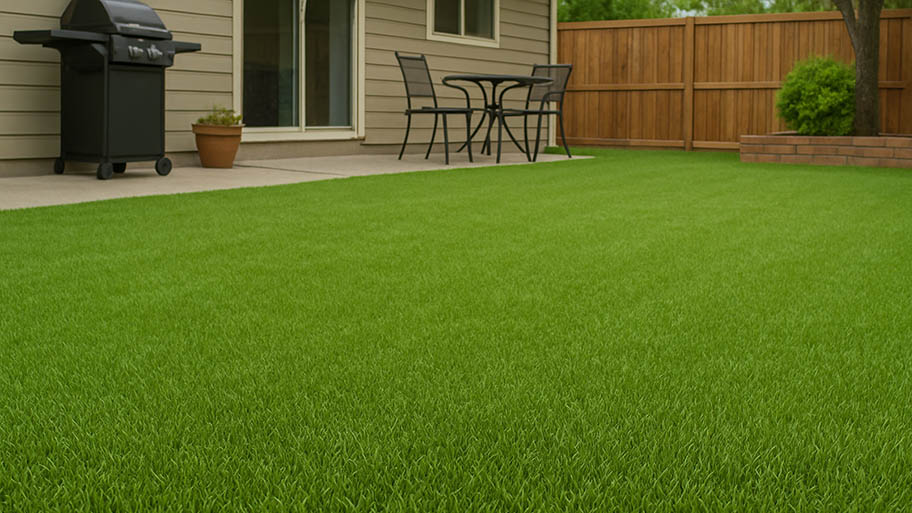
Your total lawn care cost depends on several factors, including the type of service and lawn size. Our guide will cover what you can expect to pay for lawn care.
Let it grow before you mow


Sod needs a few weeks of growth to establish before mowing, while seeds need up to two months.
Avoid cutting too close to the noon heat or nightfall to give grass the best chance to recover.
Don’t cut new grass while it’s wet to avoid long-term growth issues.
Pay attention to your grass species so you know its growth rate and the best height to start cutting.
Knowing when to mow new grass can be a challenge—even for experienced homeowners. But fear not: We can help you determine when to mow based on the type of new lawn.
It’s important to mow new grass at the right time to avoid costly mistakes. For example, if you mow too soon, you could remove your grass by the roots and negate all that hard work. If you need a hand determining when to mow, consult a lawn mowing service for expert advice. Learn the best time to mow new grass in this helpful informational guide.
Great experience from start to finish. They responded to my inquiry quickly and came out to give me a quote the same day. My yard was overgrown with weeds and needed lots of trimming. The guys came out and pulled all of the weeds by hand to get them out by the roots and trimmed up nicely. They were able to come up with a treatment plan within my budget to get my lawn and yard looking great again. Very professional, efficient and knowledgeable.
The best time to mow new grass is 8 weeks after seeding, ideally in the mid-morning or in the afternoon. Another good rule of thumb is to mow new grass when it reaches one-third higher than your ideal grass height, about 3 to 4 inches tall.
When you mow for the first time, only cut about one-third of the total height of your grass blades. Don’t overcut, especially when dealing with new grass. Cutting too much will weaken the new growth and make it more susceptible to drought, disease, bugs, or simply failing to establish.
Here are the most important factors affecting new grass growth and the best time to pull out the mower.
Sod already has a significant head start in growth, so you can plan to mow it for the first time about 3 weeks after installation. Remember to check that the sod has established firmly enough to mow. You can quickly determine whether you need the mower by tugging on a chunk of sod: if it lifts or gives easily, wait another week to mow.
On the other hand, if you planted grass from seeds, then it can take up to two months for the grass to become properly set.
Some types of grasses grow faster than others. Ryegrass and fine fescue, for example, are known to be particularly fast growers and you can expect to mow them earlier on. Species like Kentucky bluegrass grow quickly but have a long germination term, so you’ll need to stay patient. Regular watering can speed up the growth, but be careful not to overwater.
Warm, humid growing seasons like mid-spring tend to encourage turf growth and may shorten the time until you need to mow. But cold or dry weather can slow down new grass development.
You should also consider the level of grass dampness before mowing for the first time. Damp grass makes poorly cut grass. Lawnmower blades, even when sharpened, can struggle to properly cut wet grass, leading to missed patches and the dreaded lines of still-standing blades. Wait until grass is fully dry and avoid mowing after rain.
Not all grass is made to be cut at the same height, which has a significant impact on how long you should wait before mowing. St. Augustine grass does best at a medium height of 2½ to 3 inches. Tall fescue grows best at 2 to 4 inches, so it may take a bit longer to grow. Bermuda grass is infamously low and should be cut at 1 to 2 inches, so it may be ready much more quickly.
If your type of grass is especially vulnerable to hot weather or sunlight, it’s a good idea to mow after the day has cooled down, rather than risk that sensitive new grass gets damaged. Consider mowing cool-season grasses in the evening to avoid full sun exposure while cutting.
Prevent lawn mower accidents by removing yard obstacles before mowing, wearing long pants and closed-toe shoes, and avoiding contact with the machine’s hot engine. Don't forget to tune up your mower by changing the filters and replacing the blade annually.
It’s important to know when you should not mow your grass, especially if it’s new and still establishing itself. Here’s when to avoid mowing your new lawn:
Immediately after seeding or laying sod: New grass needs time to establish itself, and it’s important to give it time to grow out before mowing. For sod, this can take around three weeks. If you are seeding new grass directly in the soil, it may need up to two months to establish before mowing.
First thing in the morning: Cutting wet grass is unpleasant and ineffective, so it’s best to wait until the dew has fully dried before starting.
Around noon: While lawns can quickly recover, they are left more vulnerable after mowing, making them weaker to heat and direct sunlight. When you’re trying to establish new grass, avoid mowing around noon when temperatures are highest.
Late at night: Mowing late at night invites problems with disrupted neighbors, but it also carries risks for the lawn. Cut lawns will be more vulnerable to lower temperatures at night and the collecting dew will have a better opportunity to damage the lawn or spread fungus. Don’t mow once it starts getting dark.
During dormant seasons: It’s always best to plant grass during a lawn’s growing season and avoid planting and mowing new grass during the winter. If your new lawn is still getting established when cold temperatures hit, it may be better to leave it be through the dormant season and worry about mowing when fresh spring growth starts.
Hiring a professional lawn care service to mow your new grass is recommended to ensure the stability of your grass after its first cut. If you lay new sod or seeds, you can provide special instructions to the professionals who will use their knowledge and expertise to care for your new grass.
If you’re interested in hiring a lawn care service near you to mow, expect to pay competitive prices based on your yard size. Average lawn mowing costs range between $50 and $205, depending on the size of your yard and local labor rates in your area.
From average costs to expert advice, get all the answers you need to get your job done.

Your total lawn care cost depends on several factors, including the type of service and lawn size. Our guide will cover what you can expect to pay for lawn care.

How much it costs to rent a lawn aerator depends on what kind you rent and how long you rent it for. Read on for the full details.

Artificial grass is a low-maintenance alternative to traditional turf. Learn how much artificial grass installation costs and what affects your price.

Spot common warning signs of too much nitrogen in the lawn and learn how to fix damage from overfertilizing or pet urine to keep grass green and healthy.

Does sugar help your lawn? In some cases, yes. Keep reading to learn how you can use this sweet treat to kill weeds and keep the grass green.

Making grass greener and thicker is easy—when you know how it’s done! Find out how to make your grass green and lush with these simple tips. This guide has everything to know about making grass greener to get a beautiful, healthy lawn.